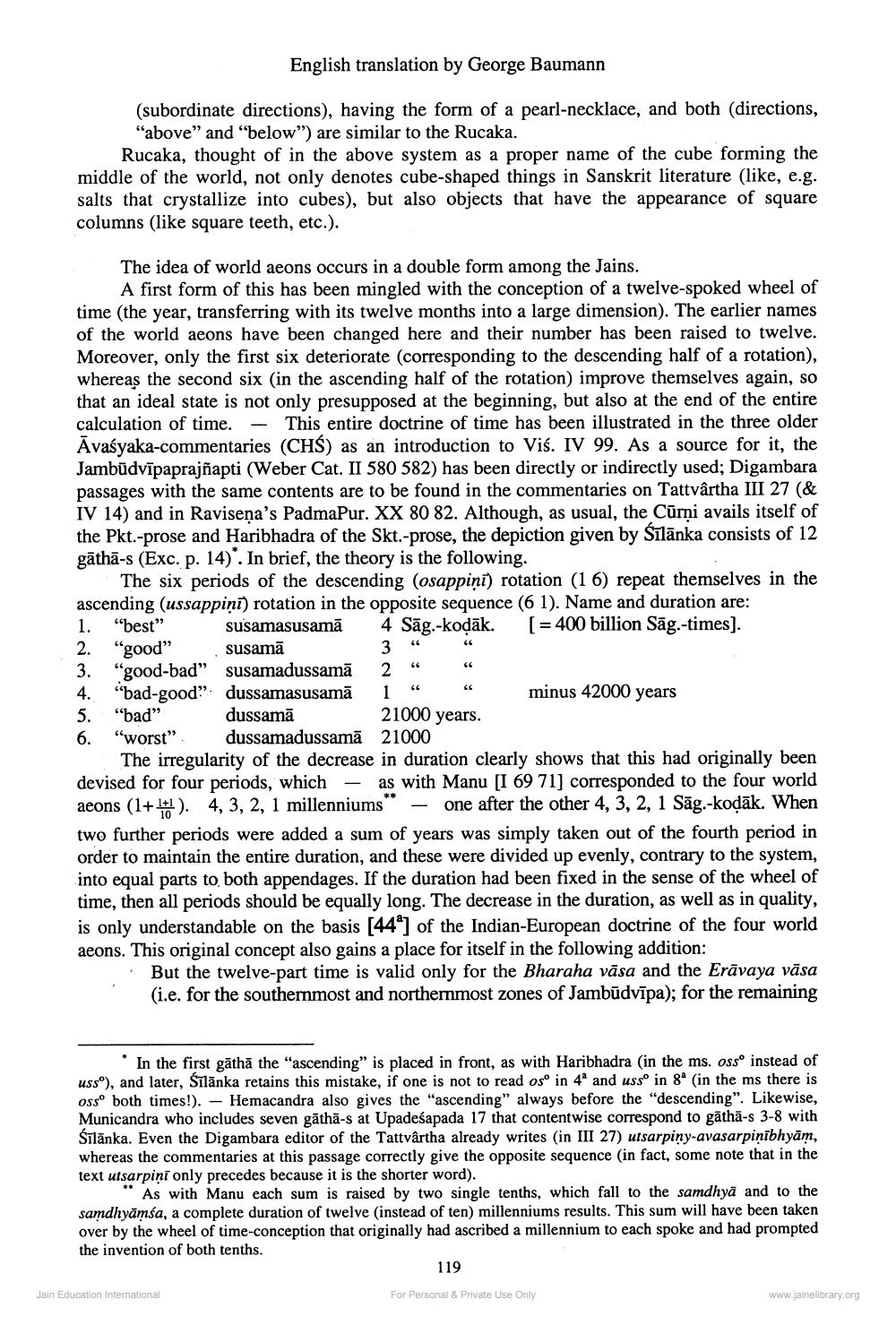________________
English translation by George Baumann
(subordinate directions), having the form of a pearl-necklace, and both (directions, "above" and "below") are similar to the Rucaka.
Rucaka, thought of in the above system as a proper name of the cube forming the middle of the world, not only denotes cube-shaped things in Sanskrit literature (like, e.g. salts that crystallize into cubes), but also objects that have the appearance of square columns (like square teeth, etc.).
The idea of world aeons occurs in a double form among the Jains.
A first form of this has been mingled with the conception of a twelve-spoked wheel of time (the year, transferring with its twelve months into a large dimension). The earlier names of the world aeons have been changed here and their number has been raised to twelve. Moreover, only the first six deteriorate (corresponding to the descending half of a rotation), whereas the second six (in the ascending half of the rotation) improve themselves again, so that an ideal state is not only presupposed at the beginning, but also at the end of the entire calculation of time. - This entire doctrine of time has been illustrated in the three older Avaśyaka-commentaries (CHS) as an introduction to Viś. IV 99. As a source for it, the Jambūdvīрaprajñapti (Weber Cat. II 580 582) has been directly or indirectly used; Digambara passages with the same contents are to be found in the commentaries on Tattvârtha III 27 (& IV 14) and in Ravisena's PadmaPur. XX 80 82. Although, as usual, the Cūrṇi avails itself of the Pkt.-prose and Haribhadra of the Skt.-prose, the depiction given by Śīlānka consists of 12 gāthā-s (Exc. p. 14)*. In brief, the theory is the following.
The six periods of the descending (osappini) rotation (16) repeat themselves in the ascending (ussappini) rotation in the opposite sequence (6 1). Name and duration are: "best"
1.
susamasusamā
4 Sāg.-koḍāk.
[= 400 billion Sāg.-times].
2.
susamā
3
"good" 3. "good-bad" susamadussamā 2
4.
"bad-good" dussamasusamā 1 5. "bad"
dussamā
6. "worst"
66
dussamadussamā 21000
Jain Education International
Co
66
21000 years.
1
CC
The irregularity of the decrease in duration clearly shows that this had originally been devised for four periods, which as with Manu [I 69 71] corresponded to the four world aeons (1+1). 4, 3, 2, 1 millenniums" one after the other 4, 3, 2, 1 Sag.-koḍāk. When
**
minus 42000 years
two further periods were added a sum of years was simply taken out of the fourth period in order to maintain the entire duration, and these were divided up evenly, contrary to the system, into equal parts to both appendages. If the duration had been fixed in the sense of the wheel of time, then all periods should be equally long. The decrease in the duration, as well as in quality, is only understandable on the basis [44] of the Indian-European doctrine of the four world aeons. This original concept also gains a place for itself in the following addition:
But the twelve-part time is valid only for the Bharaha vāsa and the Eravaya vāsa (i.e. for the southernmost and northernmost zones of Jambūdvīpa); for the remaining
In the first gatha the "ascending" is placed in front, as with Haribhadra (in the ms. oss° instead of uss°), and later, Šilanka retains this mistake, if one is not to read os° in 4a and uss° in 8a (in the ms there is oss both times!). Hemacandra also gives the "ascending" always before the "descending". Likewise, Municandra who includes seven gatha-s at Upadeśapada 17 that contentwise correspond to gāthā-s 3-8 with Śīlānka. Even the Digambara editor of the Tattvârtha already writes (in III 27) utsarpiny-avasarpiṇībhyām, whereas the commentaries at this passage correctly give the opposite sequence (in fact, some note that in the text utsarpini only precedes because it is the shorter word).
As with Manu each sum is raised by two single tenths, which fall to the samdhya and to the samdhyamsa, a complete duration of twelve (instead of ten) millenniums results. This sum will have been taken over by the wheel of time-conception that originally had ascribed a millennium to each spoke and had prompted the invention of both tenths.
119
For Personal & Private Use Only
www.jainelibrary.org




